0.15 * 9.81 / 0.101514.497536945812808import pylab, randomdef getData(filename):
distances = []
masses = []
with open(filename, 'r') as dataFile:
dataFile.readline() # discard header line
for line in dataFile:
dist, mass = line.split()
distances.append( float(dist) )
masses.append( float(mass) )
return masses, distancesdef plotData(filename):
xVals, yVals = getData(filename)
xVals = pylab.array(xVals) # vectorise
yVals = pylab.array(yVals) # vectorise
xVals = xVals * 9.81 # convert mass to Newtons by multiplying with gravitational constant
pylab.plot(xVals, yVals, 'bo', label='Measured displacements')
pylab.title('Measured Displacement of Spring')
pylab.xlabel('Force (Newtons)')
pylab.ylabel('Distance (meters)')filename = '../springData.txt'plotData(filename)
pylab.show()def testErrors(nTrials=100, sample_size=100, error_dist='random.triangular(-1,1)'):
"""
Simulates the sum of random effects.
Samples 'sample_size' random effects from the 'error_dist' and sums them up.
Repeats this 'nTrials' times and plots the distribution of sampled errors and
the distribution of the sum of sampled errors from each trial.
"""
sumsOfErrors = [0] * nTrials
Errors = [0] * nTrials * sample_size
for t in xrange(nTrials):
for s in xrange(sample_size):
error = eval(error_dist)
sumsOfErrors[t] += error
Errors[t*sample_size + s] = error
pylab.figure()
pylab.hist(Errors, bins=50)
pylab.title('Distribution of errors from ' + error_dist)
pylab.xlabel('error')
pylab.ylabel('frequency')
pylab.figure()
pylab.hist(sumsOfErrors, bins=50)
pylab.title('Sum of 100 random points from ' + error_dist + ' (' + str(nTrials) + ' Trials)')
pylab.xlabel('Sum')
pylab.ylabel('Number of trials')l = [0] * 10 * 10
print l
for i in range(10):
for j in range(10):
l[i*10+j] = 1
print l[0, 0, 0, 0, 0, 0, 0, 0, 0, 0, 0, 0, 0, 0, 0, 0, 0, 0, 0, 0, 0, 0, 0, 0, 0, 0, 0, 0, 0, 0, 0, 0, 0, 0, 0, 0, 0, 0, 0, 0, 0, 0, 0, 0, 0, 0, 0, 0, 0, 0, 0, 0, 0, 0, 0, 0, 0, 0, 0, 0, 0, 0, 0, 0, 0, 0, 0, 0, 0, 0, 0, 0, 0, 0, 0, 0, 0, 0, 0, 0, 0, 0, 0, 0, 0, 0, 0, 0, 0, 0, 0, 0, 0, 0, 0, 0, 0, 0, 0, 0]
[1, 1, 1, 1, 1, 1, 1, 1, 1, 1, 1, 1, 1, 1, 1, 1, 1, 1, 1, 1, 1, 1, 1, 1, 1, 1, 1, 1, 1, 1, 1, 1, 1, 1, 1, 1, 1, 1, 1, 1, 1, 1, 1, 1, 1, 1, 1, 1, 1, 1, 1, 1, 1, 1, 1, 1, 1, 1, 1, 1, 1, 1, 1, 1, 1, 1, 1, 1, 1, 1, 1, 1, 1, 1, 1, 1, 1, 1, 1, 1, 1, 1, 1, 1, 1, 1, 1, 1, 1, 1, 1, 1, 1, 1, 1, 1, 1, 1, 1, 1]%matplotlib inlinetestErrors(nTrials=10000)
pylab.show()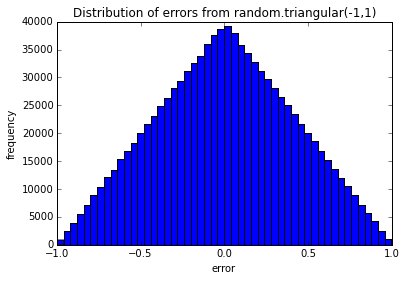
png
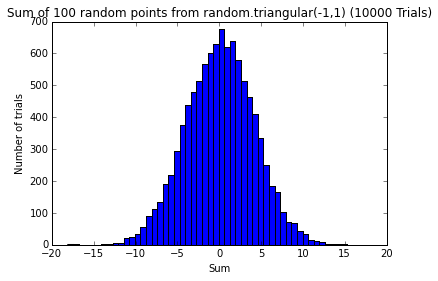
png
testErrors(nTrials=10000, error_dist='random.uniform(-1,1)')
pylab.show()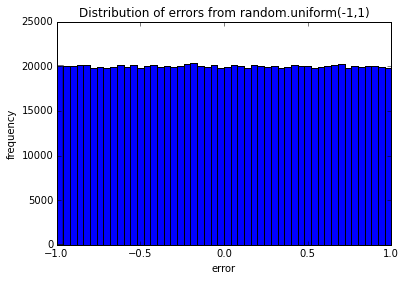
png
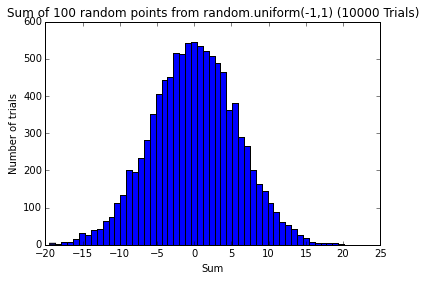
png
testErrors(nTrials=10000, error_dist='random.gammavariate(alpha=3,beta=30)')
pylab.show()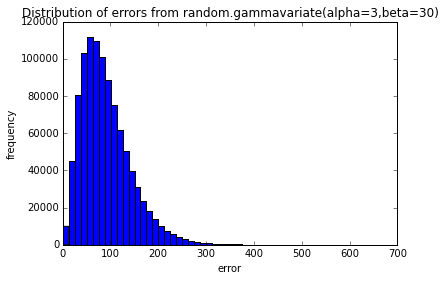
png
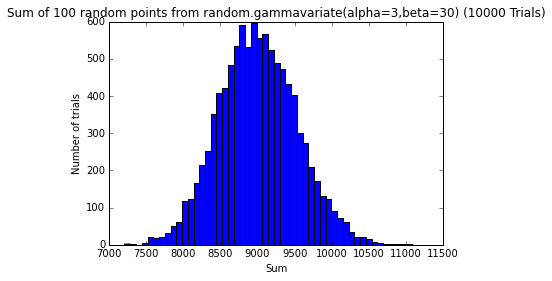
png
testErrors(nTrials=10000, error_dist='random.lognormvariate(mu=0, sigma=1)')
pylab.show()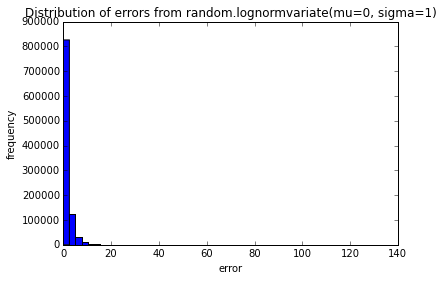
png
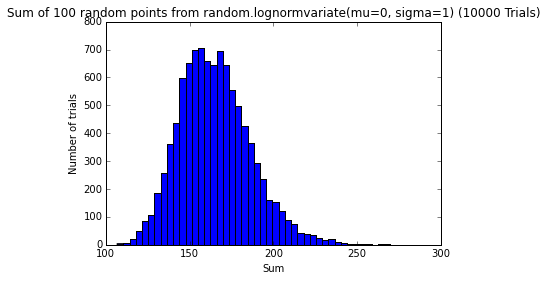
png
The sum of random errors, no matter what their distribution, seems to converge to a normal distribution.
a = [0] * 1000
b = [0] * 1000
for i in range(1000):
a[i] = random.gauss(mu=0, sigma=3)
b[i] = random.gauss(mu=0, sigma=5)
pylab.figure()
pylab.hist(a, bins=10)
pylab.figure()
pylab.hist(b, bins=10)
pylab.show()216/8.027.0import random, pylabdef testHashFunc(N):
l = []
for _ in range(N):
l.extend([random.randint(0,99) % 10 for _ in range(100)])
pylab.hist(l, bins=10)
pylab.title('N = ' + str(N))
pylab.show()testHashFunc(10)
testHashFunc(100)
testHashFunc(1000)xVals = []
yVals = []
wVals = []
for i in range(1000):
xVals.append(random.random())
yVals.append(random.random())
wVals.append(random.random())
xVals = pylab.array(xVals)
yVals = pylab.array(yVals)
wVals = pylab.array(wVals)
xVals = xVals + xVals
zVals = xVals + yVals
tVals = xVals + yVals + wValspylab.hist(tVals, bins=15)
pylab.show()The sum of random numbers is normally distributed!
pylab.hist(xVals, bins=15)
pylab.show()pylab.plot(xVals, zVals)
pylab.show()Although the zVals are normally distributed they are positively correlated with the xVals.
pylab.plot(xVals, yVals)
pylab.show()Both xVals and yVals are uniformly distributed.
pylab.plot(xVals, sorted(yVals))
pylab.show()Fix the backend of matplotlib to allow figures to show up
import matplotlib
print matplotlib.matplotlib_fname()/Users/Claudius/anaconda/lib/python2.7/site-packages/matplotlib/mpl-data/matplotlibrcbackend : qt2agg
Fiiting a Curve to data
def fitData(fileName):
"""
Uses pylab's 'polyfit' function to fit a straight line to the data,
i. e. to do a linear regression
"""
xVals, yVals = getData(fileName)
xVals = pylab.array(xVals)
yVals = pylab.array(yVals)
xVals = xVals*9.81 # convert mass to force (F = mg)
pylab.plot(xVals, yVals, 'bo', label = 'Measured points')
pylab.title('Measured Displacement of Spring')
pylab.xlabel('Force (Newtons)')
pylab.ylabel('Distance (meters)')
a,b = pylab.polyfit(xVals, yVals, 1) # fit y = ax + b
# use line equation to graph predicted values
estYVals = a*xVals + b
k = 1/a
pylab.plot(xVals, estYVals, label = 'Linear fit, k = '
+ str(round(k, 5)))
pylab.legend(loc = 'best')fileName = '../springData.txt'
fitData(filename)
pylab.show()def fitData1(fileName):
"""
Does linear and cubic regression of data and plots those curves with the data
"""
xVals, yVals = getData(fileName)
xVals = pylab.array(xVals)
yVals = pylab.array(yVals)
xVals = xVals*9.81 # convert mass to force (F = mg)
pylab.plot(xVals, yVals, 'bo', label = 'Measured displacements')
pylab.title('Measured Displacement of Spring')
pylab.xlabel('|Force| (Newtons)')
pylab.ylabel('Distance (meters)')
# linear regression
a,b = pylab.polyfit(xVals, yVals, 1)
estYVals = a*xVals + b
pylab.plot(xVals, estYVals, label = 'Linear fit')
# cubic regresson
a,b,c,d = pylab.polyfit(xVals, yVals, 3)
estYVals = a*(xVals**3) + b*xVals**2 + c*xVals + d
pylab.plot(xVals, estYVals, label = 'Cubic fit')
pylab.legend(loc = 'best')fileName = '../springData.txt'
fitData1(filename)
pylab.show()def fitData2(fileName):
"""
"""
xVals, yVals = getData(fileName)
# add some potential heavier masses that haven't been tried yet:
extX = pylab.array(xVals + [1.05, 1.1, 1.15, 1.2, 1.25])
xVals = pylab.array(xVals)
yVals = pylab.array(yVals)
xVals = xVals*9.81 # convert mass to force (F = mg)
extX = extX*9.81 # convert mass to force (F = mg)
pylab.plot(xVals, yVals, 'bo', label = 'Measured displacements')
pylab.title('Measured Displacement of Spring')
pylab.xlabel('|Force| (Newtons)')
pylab.ylabel('Distance (meters)')
# linear regression:
a,b = pylab.polyfit(xVals, yVals, 1)
estYVals = a*extX + b
pylab.plot(extX, estYVals, label = 'Linear fit')
# cubic regression
a,b,c,d = pylab.polyfit(xVals, yVals, 3)
estYVals = a*(extX**3) + b*extX**2 + c*extX + d
pylab.plot(extX, estYVals, label = 'Cubic fit')
pylab.legend(loc = 'best')fileName = '../springData.txt'
fitData2(filename)
pylab.show()The prediction from the cubic model does not make sense.
def fitData3(fileName):
xVals, yVals = getData(fileName)
# remove last 6 values from data, for which Hooks law might not apply:
xVals = pylab.array(xVals[:-6])
yVals = pylab.array(yVals[:-6])
xVals = xVals*9.81 # convert mass to force (F = mg)
pylab.plot(xVals, yVals, 'bo', label = 'Measured points')
pylab.title('Measured Displacement of Spring')
pylab.xlabel('Force (Newtons)')
pylab.ylabel('Distance (meters)')
a,b = pylab.polyfit(xVals, yVals, 1) # fix y = ax + b
# use line equation to graph predicted values
estYVals = a*xVals + b
k = 1/a
pylab.plot(xVals, estYVals, label = 'Linear fit, k = '
+ str(round(k, 5)))
pylab.legend(loc = 'best')fileName = '../springData.txt'
fitData3(filename)
pylab.show()Goodness of Fit of a model to data
Heigth of flying arrow measured in 4 replicates and over a range of distances.
def getTrajectoryData(fileName):
"""
reads the data in the launcherData.txt file
"""
dataFile = open(fileName, 'r')
distances = []
heights1, heights2, heights3, heights4 = [],[],[],[]
discardHeader = dataFile.readline()
for line in dataFile:
d, h1, h2, h3, h4 = line.split()
distances.append(float(d))
heights1.append(float(h1))
heights2.append(float(h2))
heights3.append(float(h3))
heights4.append(float(h4))
dataFile.close()
return (distances, [heights1, heights2, heights3, heights4])def tryFits(fName):
"""
plots the mean of the height measurements over the distances as well as
a linear and quadratic fit
"""
distances, heights = getTrajectoryData(fName)
distances = pylab.array(distances)*36 # conversion from yeards to inches
# get average of height measurements for each distance
totHeights = pylab.array([0]*len(distances))
for h in heights: # 'heights' is an array of arrays
totHeights = totHeights + pylab.array(h) # vectorised addition
meanHeights = totHeights/float(len(heights))
# plot the data
pylab.title('Trajectory of Projectile (Mean of 4 Trials)')
pylab.xlabel('Inches from Launch Point')
pylab.ylabel('Inches Above Launch Point')
pylab.plot(distances, meanHeights, 'bo')
# linear regression
a,b = pylab.polyfit(distances, meanHeights, 1)
altitudes = a*distances + b
pylab.plot(distances, altitudes, 'r',
label = 'Linear Fit')
# quadratic polynomial regression (second degree)
a,b,c = pylab.polyfit(distances, meanHeights, 2)
altitudes = a*(distances**2) + b*distances + c
pylab.plot(distances, altitudes, 'g',
label = 'Quadratic Fit')
pylab.legend()?pylab.polyfit%matplotlib inline
tryFits('../launcherData.txt')
pylab.show()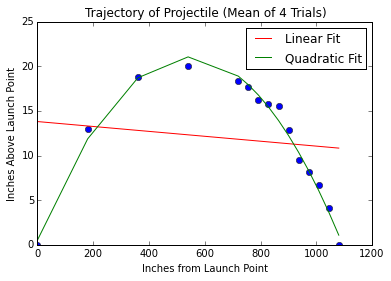
png
\(R^{2}\) is a measure of the goodness of fit of a model to data and can be interpreted as the proportion of variance explained by the model:
\[ R^{2} = 1 - \frac{\sigma_{residual}^{2}}{\sigma_{total}^{2}} \]
The variance of residuals \(\sigma_{residual}^{2}\) is the variance unexplained by the model.
def rSquare(measured, estimated):
"""
measured: one dimensional array of measured values
estimate: one dimensional array of predicted values
returns the coefficient of determination R squared
"""
SS_res = ((estimated - measured)**2).sum() # sum of squares of residuals
data_mean = measured.sum()/float(len(measured)) # mean of all data values
SS_tot = ((data_mean - measured)**2).sum() # total sum of squares
return 1 - SS_res/SS_totdef tryFits1(fName):
distances, heights = getTrajectoryData(fName)
distances = pylab.array(distances)*36
totHeights = pylab.array([0]*len(distances))
# get average of height measurements for each distance
for h in heights:
totHeights = totHeights + pylab.array(h)
meanHeights = totHeights/float(len(heights))
# plot data
pylab.title('Trajectory of Projectile (Mean of 4 Trials)')
pylab.xlabel('Inches from Launch Point')
pylab.ylabel('Inches Above Launch Point')
pylab.plot(distances, meanHeights, 'bo')
# linear regression
a,b = pylab.polyfit(distances, meanHeights, 1)
altitudes = a*distances + b
pylab.plot(distances, altitudes, 'r',
label = 'Linear Fit' + ', R2 = '
+ str(round(rSquare(meanHeights, altitudes), 4))) # include R^2 in legend
# quadratic regression
a,b,c = pylab.polyfit(distances, meanHeights, 2)
altitudes = a*(distances**2) + b*distances + c
pylab.plot(distances, altitudes, 'g',
label = 'Quadratic Fit' + ', R2 = '
+ str(round(rSquare(meanHeights, altitudes), 4))) # include R^2 in legend
pylab.legend(loc="lower center")tryFits1('../launcherData.txt')
pylab.show()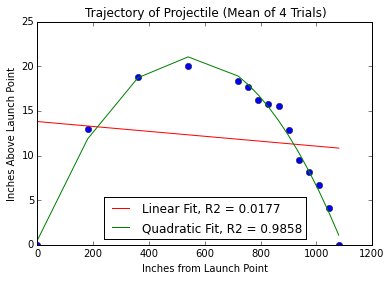
png
?pylab.legend()def fitDataWithRsquare(fileName):
"""
Uses pylab's 'polyfit' function to fit a straight line to the data,
i. e. to do a linear regression
"""
# get data from file
xVals, yVals = getData(fileName)
xVals = pylab.array(xVals)
yVals = pylab.array(yVals)
xVals = xVals*9.81 # convert mass to force (F = mg)
# plot the data
pylab.plot(xVals, yVals, 'bo', label = 'Measured points')
pylab.title('Measured Displacement of Spring')
pylab.xlabel('Force (Newtons)')
pylab.ylabel('Distance (meters)')
# first degree linear regression
a,b = pylab.polyfit(xVals, yVals, 1) # fit y = ax + b
# use line equation to graph predicted values
estYVals = a*xVals + b
pylab.plot(xVals, estYVals, label = 'Linear fit, R = '
+ str(round(rSquare(yVals, estYVals), 5)))
pylab.legend(loc = 'best')fitDataWithRsquare('../springData.txt')
pylab.show()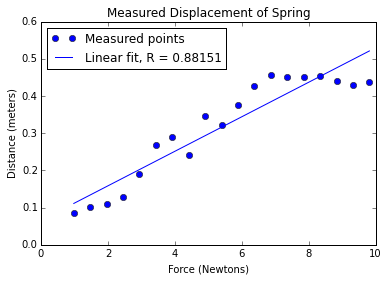
png
def fitData3WithRsquare(fileName):
"""
Uses pylab's 'polyfit' function to fit a straight line to the data,
i. e. to do a linear regression
"""
# get data from file
xVals, yVals = getData(fileName)
# remove last six data points where Hooke's law might not apply:
xVals = pylab.array(xVals[:-6]) # skip last 6 values
yVals = pylab.array(yVals[:-6])
xVals = xVals*9.81 # convert mass to force (F = mg)
# plot the data
pylab.plot(xVals, yVals, 'bo', label = 'Measured points')
pylab.title('Measured Displacement of Spring')
pylab.xlabel('Force (Newtons)')
pylab.ylabel('Distance (meters)')
# first degree linear regression
a,b = pylab.polyfit(xVals, yVals, 1) # fit y = ax + b
# use line equation to graph predicted values
estYVals = a*xVals + b
pylab.plot(xVals, estYVals, label = 'Linear fit, R^2 = '
+ str(round(rSquare(yVals, estYVals), 4)))
pylab.legend(loc = 'best')fitData3WithRsquare('../springData.txt')
pylab.show()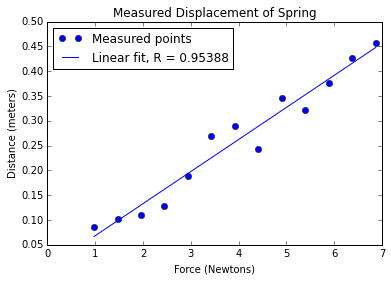
png
The Effect of Delaying Treatment on Patient Disease
This problem set makes use of classes that I have defined for the problem set of last week: simulating virus population in patient and effect of drugs.
Instead of copying all the code into this notebook, I have converted the Monte-Carlosimulations.ipynb to pure python with jupyter nbconvert --to python Monte-Carlosimulations.ipynb. I am going to import this script as a module.
The directories where python looks for modules are:
import sys
print sys.path['', '/Users/Claudius/anaconda/lib/python27.zip', '/Users/Claudius/anaconda/lib/python2.7', '/Users/Claudius/anaconda/lib/python2.7/plat-darwin', '/Users/Claudius/anaconda/lib/python2.7/plat-mac', '/Users/Claudius/anaconda/lib/python2.7/plat-mac/lib-scriptpackages', '/Users/Claudius/anaconda/lib/python2.7/lib-tk', '/Users/Claudius/anaconda/lib/python2.7/lib-old', '/Users/Claudius/anaconda/lib/python2.7/lib-dynload', '/Users/Claudius/anaconda/lib/python2.7/site-packages/Sphinx-1.3.1-py2.7.egg', '/Users/Claudius/anaconda/lib/python2.7/site-packages/setuptools-18.5-py2.7.egg', '/Users/Claudius/anaconda/lib/python2.7/site-packages', '/Users/Claudius/anaconda/lib/python2.7/site-packages/aeosa', '/Users/Claudius/anaconda/lib/python2.7/site-packages/IPython/extensions', '/Users/Claudius/.ipython']I can modify the python path to make it look for modules in custom places first:
sys.path = ['/Users/Claudius/Dropbox/MITx_6.00.2x_Introduction_to_Computational_Thinking_and_Data_Science'] + sys.path
print sys.path['/Users/Claudius/Dropbox/MITx_6.00.2x_Introduction_to_Computational_Thinking_and_Data_Science', '', '/Users/Claudius/anaconda/lib/python27.zip', '/Users/Claudius/anaconda/lib/python2.7', '/Users/Claudius/anaconda/lib/python2.7/plat-darwin', '/Users/Claudius/anaconda/lib/python2.7/plat-mac', '/Users/Claudius/anaconda/lib/python2.7/plat-mac/lib-scriptpackages', '/Users/Claudius/anaconda/lib/python2.7/lib-tk', '/Users/Claudius/anaconda/lib/python2.7/lib-old', '/Users/Claudius/anaconda/lib/python2.7/lib-dynload', '/Users/Claudius/anaconda/lib/python2.7/site-packages/Sphinx-1.3.1-py2.7.egg', '/Users/Claudius/anaconda/lib/python2.7/site-packages/setuptools-18.5-py2.7.egg', '/Users/Claudius/anaconda/lib/python2.7/site-packages', '/Users/Claudius/anaconda/lib/python2.7/site-packages/aeosa', '/Users/Claudius/anaconda/lib/python2.7/site-packages/IPython/extensions', '/Users/Claudius/.ipython']import Monte_Carlo_simulations as VIRUSdir(VIRUS)['NoChildException',
'Patient',
'ResistantVirus',
'SimpleVirus',
'TreatedPatient',
'__builtins__',
'__doc__',
'__file__',
'__name__',
'__package__',
'mark_recap',
'numpy',
'pylab',
'random',
'sim_mark_recap',
'simulationWithDrug',
'simulationWithoutDrug']v = VIRUS.SimpleVirus(maxBirthProb=0.5, clearProb=0.01)import inspect
print inspect.getsource(VIRUS.simulationWithDrug)def simulationWithDrug(numViruses, maxPop, maxBirthProb, clearProb, resistances,
mutProb, numTrials):
"""
Runs simulations and plots graphs for problem 5.
For each of numTrials trials, instantiates a patient, runs a simulation for
150 timesteps, adds guttagonol, and runs the simulation for an additional
150 timesteps. At the end plots the average virus population size
(for both the total virus population and the guttagonol-resistant virus
population) as a function of time.
numViruses: number of ResistantVirus to create for patient (an integer)
maxPop: maximum virus population for patient (an integer)
maxBirthProb: Maximum reproduction probability (a float between 0-1)
clearProb: maximum clearance probability (a float between 0-1)
resistances: a dictionary of drugs that each ResistantVirus is resistant to
(e.g., {'guttagonol': False})
mutProb: mutation probability for each ResistantVirus particle
(a float between 0-1).
numTrials: number of simulation runs to execute (an integer)
"""
timesteps = 300
virusTotalPop = [0] * timesteps
virusResistPop = [0] * timesteps
for _ in range(numTrials):
# it is important to initialise the patient for each trial with a new list of
# virus instances
viruses = []
for _ in range(numViruses):
viruses.append( ResistantVirus(maxBirthProb, clearProb, resistances, mutProb) )
#for v in viruses:
# print v.getResistances()
p = TreatedPatient(viruses, maxPop)
for i in range(timesteps/2):
virusTotalPop[i] += p.update()
virusResistPop[i] += p.getResistPop( resistances.keys() )
p.addPrescription('guttagonol')
for i in range(timesteps/2, timesteps):
virusTotalPop[i] += p.update()
virusResistPop[i] += p.getResistPop( resistances.keys() )
for i in range(timesteps):
virusTotalPop[i] /= float(numTrials)
virusResistPop[i] /= float(numTrials)
pylab.plot(virusTotalPop, label='total')
pylab.plot(virusResistPop, label='resistant')
pylab.xlabel('time steps')
pylab.ylabel('virus population size')
pylab.title('virus number over time')
pylab.legend()
pylab.show()def simulationDelayedTreatment(numTrials=10, maxPop=1000, numViruses=100, \
maxBirthProb=0.1, clearProb=0.05, resistances={'guttagonol': False}, mutProb=0.005, \
delays=(300, 150, 75, 0)):
"""
Runs simulations and make histograms for problem 1.
Runs numTrials simulations to show the relationship between delayed
treatment and patient outcome using a histogram.
Histograms of final total virus populations are displayed for delays of 300,
150, 75, 0 timesteps (followed by an additional 150 timesteps of
simulation).
numTrials: number of simulation runs to execute (an integer)
numViruses: number of ResistantVirus to create for patient (an integer)
maxPop: maximum virus population for patient (an integer)
maxBirthProb: Maximum reproduction probability (a float between 0-1)
clearProb: maximum clearance probability (a float between 0-1)
resistances: a dictionary of drugs that each ResistantVirus is resistant to
(e.g., {'guttagonol': False})
mutProb: mutation probability for each ResistantVirus particle
(a float between 0-1).
delays: number time steps before treatment starts (tuple)
"""
virusTotalPop = {}
for _ in range(numTrials):
for delay in delays:
# it is important to initialise the patient for each trial and delay with a new list of
# virus instances
viruses = []
for _ in range(numViruses):
viruses.append( VIRUS.ResistantVirus(maxBirthProb, clearProb, resistances, mutProb) )
#for v in viruses:
# print v.getResistances()
p = VIRUS.TreatedPatient(viruses, maxPop)
for _ in range(delay):
p.update()
#p.getResistPop( resistances.keys() )
p.addPrescription('guttagonol')
for _ in range(150-1):
p.update()
#p.getResistPop( resistances.keys() )
virusTotalPop.setdefault(delay, []).append( p.update() )
# create histograms
for delay in delays:
# print delay, virusTotalPop[delay]
pylab.figure()
pylab.hist(virusTotalPop[delay], bins=(max(virusTotalPop)-min(virusTotalPop))/15, label='number of trials ' + str(numTrials))
#pylab.hist(virusResistPop, label='resistant')
pylab.xlabel('total final virus population')
pylab.ylabel('frequency')
pylab.title('treatment delayed for ' + str(delay) + ' steps')
pylab.legend()import pylab
%matplotlib inline
%time
simulationDelayedTreatment(numTrials=100)
pylab.show()CPU times: user 4 µs, sys: 1 µs, total: 5 µs
Wall time: 10 µs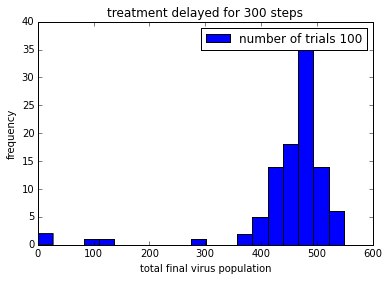
png
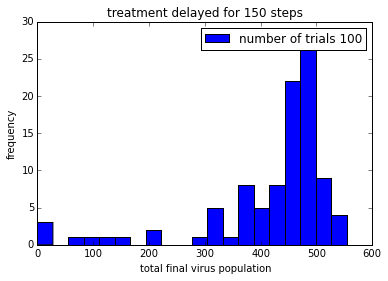
png
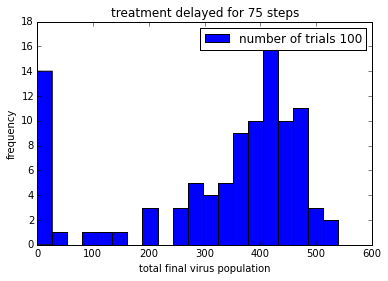
png
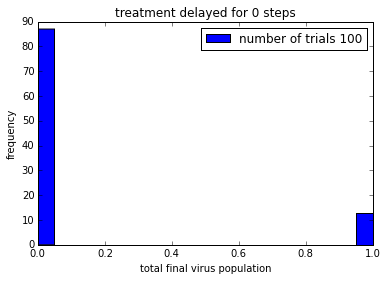
png
Remember that the drug does not kill the virus. It just stops it from reproducing, so that viruses are gradually “cleared” from the patient.
In order to be able to make it easier to compare these plot, it would be good to get them on the same axis scale.
Do pyplot tutorial !
Designing a Treatment Plan With Two Drugs
def simulationTwoDrugsDelayedTreatment(numTrials=10, numViruses=100, maxPop=1000, maxBirthProb=0.1, \
clearProb=0.05, resistances={'guttagonol': False, 'grimpex': False}, mutProb=0.005,\
delays=(300, 150, 75, 0)):
"""
Runs simulations and make histograms for problem 2.
Runs numTrials simulations to show the relationship between administration
of multiple drugs and patient outcome.
Histograms of final total virus populations are displayed for lag times of
300, 150, 75, 0 timesteps between adding drugs (followed by an additional
150 timesteps of simulation).
numTrials: number of simulation runs to execute (an integer)
"""
virusTotalPop = {}
for _ in range(numTrials):
for delay in delays:
# it is important to initialise the patient for each trial and delay with a new list of
# virus instances
viruses = []
for _ in range(numViruses):
viruses.append( VIRUS.ResistantVirus(maxBirthProb, clearProb, resistances, mutProb) )
#for v in viruses:
# print v.getResistances()
p = VIRUS.TreatedPatient(viruses, maxPop)
# run simulation for 150 generations without drug
for _ in range(150):
p.update()
# administer first drug to the patient
p.addPrescription('guttagonol')
# run simulation for 'delay' number of generations
# before administering the second drug
for _ in range(delay):
p.update()
#p.getResistPop( resistances.keys() )
p.addPrescription('grimpex')
# finally run the simulation for another 150 generations
# and store the final total virus population size
for _ in range(150-1):
p.update()
#p.getResistPop( resistances.keys() )
virusTotalPop.setdefault(delay, []).append( p.update() )
# create histograms
for delay in delays:
# print delay, virusTotalPop[delay]
pylab.figure()
pylab.hist(virusTotalPop[delay], bins=int((max(virusTotalPop)-min(virusTotalPop))/15)+1, label='number of trials ' + str(numTrials))
#pylab.hist(virusResistPop, label='resistant')
pylab.xlabel('total final virus population')
pylab.ylabel('frequency')
pylab.title('second drug administered after ' + str(150+delay) + ' steps')
pylab.legend()%matplotlib inline
%time
simulationTwoDrugsDelayedTreatment(numTrials=100)
pylab.show()CPU times: user 4 µs, sys: 1 µs, total: 5 µs
Wall time: 10 µs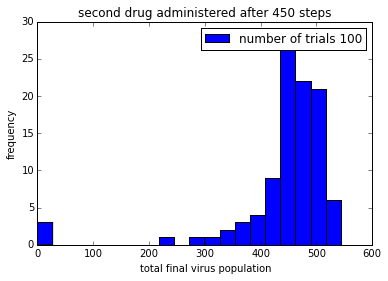
png
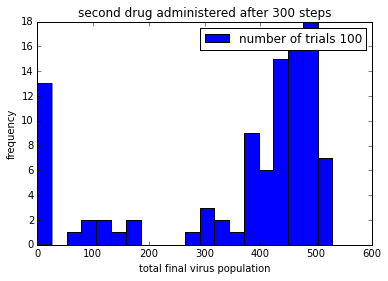
png

png
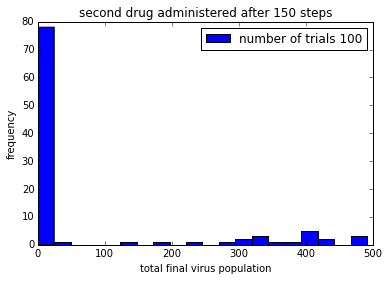
png
What is the relationship between onset of first drug administration and probability of recovery or remission of patients?
To answer that question I need to modify the previous simulation function.
def sim2DrugsDelayedTreat(numTrials=10, numViruses=100, maxPop=1000, maxBirthProb=0.1, \
clearProb=0.05, resistances={'guttagonol': False, 'grimpex': False}, mutProb=0.005,\
delays=(150,), steps_without_drugs=150):
"""
Runs simulations and make histograms for problem 2.
Runs numTrials simulations to show the relationship between the first administration
of multiple drugs and patient outcome.
numTrials: number of simulation runs to execute (an integer)
Returns the number of cured patients or patients in remission (with up to 50 viruses in body).
"""
virusTotalPop = {}
for _ in range(numTrials):
for delay in delays:
# it is important to initialise the patient for each trial and delay with a new list of
# virus instances
viruses = []
for _ in range(numViruses):
viruses.append( VIRUS.ResistantVirus(maxBirthProb, clearProb, resistances, mutProb) )
#for v in viruses:
# print v.getResistances()
p = VIRUS.TreatedPatient(viruses, maxPop)
# run simulation for 150 generations without drug
for _ in range(steps_without_drugs):
p.update()
# administer first drug to the patient
p.addPrescription('guttagonol')
# run simulation for 'delay' number of generations
# before administering the second drug
for _ in range(delay):
p.update()
#p.getResistPop( resistances.keys() )
p.addPrescription('grimpex')
# finally run the simulation for another 150 generations
# and store the final total virus population size
for _ in range(150-1):
p.update()
#p.getResistPop( resistances.keys() )
virusTotalPop.setdefault(delay, []).append( p.update() )
# count how often a final total virus population was below 51
import numpy as np
for d in delays:
virusTotalPop[d] = np.array(virusTotalPop[d])
return sum(virusTotalPop[d] < 51)x = (0, 25, 50, 100, 200, 300)
y = [0] * len(x)
for i in range(len(x)):
y[i] = sim2DrugsDelayedTreat(numTrials=100, steps_without_drugs=x[i])pylab.plot(x, y, 'bo-')
pylab.xlabel('generations without drugs')
pylab.ylabel('number of cured patients')
pylab.title('relationship between onset of treatment\n and number cured patients')
pylab.show()
png
The relationship between number of cured patients and when the delay occurs is NOT linear. Most of the reduction in cured patients happens in the time window ip to 100 virus generations. After that a further delay in first drug administration does only minimally reduce the number of cured patients.
Of the four delay values tested, which has the lowest variance?
def simulationTwoDrugsDelayedTreatment(numTrials=10, numViruses=100, maxPop=1000, maxBirthProb=0.1, \
clearProb=0.05, resistances={'guttagonol': False, 'grimpex': False}, mutProb=0.005,\
delays=(300, 150, 75, 0)):
"""
Runs simulations and make histograms for problem 2.
Runs numTrials simulations to show the relationship between administration
of multiple drugs and patient outcome.
Histograms of final total virus populations are displayed for lag times of
300, 150, 75, 0 timesteps between adding drugs (followed by an additional
150 timesteps of simulation).
numTrials: number of simulation runs to execute (an integer)
"""
virusTotalPop = {}
for _ in range(numTrials):
for delay in delays:
# it is important to initialise the patient for each trial and delay with a new list of
# virus instances
viruses = []
for _ in range(numViruses):
viruses.append( VIRUS.ResistantVirus(maxBirthProb, clearProb, resistances, mutProb) )
#for v in viruses:
# print v.getResistances()
p = VIRUS.TreatedPatient(viruses, maxPop)
# run simulation for 150 generations without drug
for _ in range(150):
p.update()
# administer first drug to the patient
p.addPrescription('guttagonol')
# run simulation for 'delay' number of generations
# before administering the second drug
for _ in range(delay):
p.update()
#p.getResistPop( resistances.keys() )
p.addPrescription('grimpex')
# finally run the simulation for another 150 generations
# and store the final total virus population size
for _ in range(150-1):
p.update()
#p.getResistPop( resistances.keys() )
virusTotalPop.setdefault(delay, []).append( p.update() )
# create histograms
import numpy as np
for delay in delays:
v = np.array(virusTotalPop[delay])
avg = sum(v)/float(len(v))
var = sum( (v - avg)**2 )/float(len(v))
print "The variance of the final virus populations for delay %d is %.1f." % (delay, var)simulationTwoDrugsDelayedTreatment(numTrials=100)The variance of the final virus populations for delay 300 is 10131.6.
The variance of the final virus populations for delay 150 is 22719.3.
The variance of the final virus populations for delay 75 is 44788.6.
The variance of the final virus populations for delay 0 is 13109.1.A delay of 300 generations before the second drug administration has the lowest variance in final virus population, closely followed by the variance for no delay, which is not surprising given that most patients get fully cured (no viruses left).
import numpy as np
l = [10, 4, 38, 444]
l = np.array(l)l > 10array([False, False, True, True], dtype=bool)sum(l > 10)2print inspect.getsource(VIRUS.TreatedPatient)class TreatedPatient(Patient):
"""
Representation of a patient. The patient is able to take drugs and his/her
virus population can acquire resistance to the drugs he/she takes.
"""
def __init__(self, viruses, maxPop):
"""
Initialization function, saves the viruses and maxPop parameters as
attributes. Also initializes the list of drugs being administered
(which should initially include no drugs).
viruses: The list representing the virus population (a list of
virus instances)
maxPop: The maximum virus population for this patient (an integer)
"""
Patient.__init__(self, viruses, maxPop)
self.drugs = set()
def addPrescription(self, newDrug):
"""
Administer a drug to this patient. After a prescription is added, the
drug acts on the virus population for all subsequent time steps. If the
newDrug is already prescribed to this patient, the method has no effect.
newDrug: The name of the drug to administer to the patient (a string).
postcondition: The list of drugs being administered to a patient is updated
"""
self.drugs.add(newDrug)
def getPrescriptions(self):
"""
Returns the drugs that are being administered to this patient.
returns: The list of drug names (strings) being administered to this
patient.
"""
return self.drugs
def getResistPop(self, drugResist):
"""
Get the population of virus particles resistant to the drugs listed in
drugResist.
drugResist: Which drug resistances to include in the population (a list
of strings - e.g. ['guttagonol'] or ['guttagonol', 'srinol'])
returns: The population of viruses (an integer) with resistances to all
drugs in the drugResist list.
"""
if len(drugResist) == 0: return 0
count = 0
for v in self.viruses:
resistAll = True
for d in drugResist:
if not v.isResistantTo(d):
resistAll = False
break
if resistAll:
count += 1
return count
def update(self):
"""
Update the state of the virus population in this patient for a single
time step. update() should execute these actions in order:
- Determine whether each virus particle survives and update the list of
virus particles accordingly
- The current population density is calculated. This population density
value is used until the next call to update().
- Based on this value of population density, determine whether each
virus particle should reproduce and add offspring virus particles to
the list of viruses in this patient.
The list of drugs being administered should be accounted for in the
determination of whether each virus particle reproduces.
returns: The total virus population at the end of the update (an
integer)
"""
self.surviving = []
for v in self.viruses:
if not v.doesClear():
self.surviving.append(v)
self.viruses = self.surviving
self.popDensity = self.getTotalPop() / float(self.maxPop)
self.new_viruses = []
for v in self.viruses:
try:
self.new_viruses.append( v.reproduce(self.popDensity, self.drugs) )
except NoChildException:
continue
self.viruses.extend(self.new_viruses)
return self.getTotalPop()